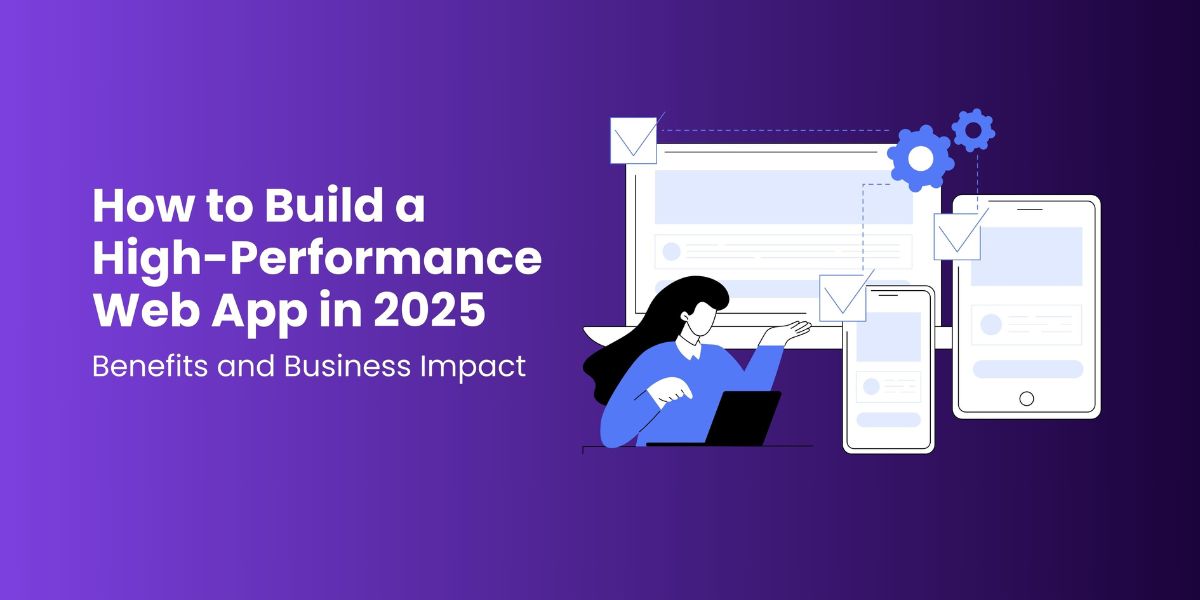In 2025, web apps aren’t just digital storefronts or online portals, they’re full-blown platforms that power global businesses, streamline operations, and deliver seamless user experiences. It now becomes super important to build a high-performing web app, as the user experience is growing and competition is super high.
A high-performance web app can mean the difference between a loyal user and a bounced visitor, between a smooth sale and an abandoned cart. That’s why modern web application development demands more than just clean code—it requires strategy, scalability, and speed.
In this guide, we’ll walk you through the latest best practices, tools, and architectural decisions to help you build a web app that performs, scales, and thrives in 2025.
Why Performance Matters More Than Ever
User expectations have evolved.
- 53% of users abandon a site that takes longer than 3 seconds to load
- Google considers page speed a ranking factor in search results
- Faster apps drive better engagement, higher conversions, and lower bounce rates
If you’re investing in web application development, performance needs to be a top priority, not an afterthought.
Step-by-Step Guide to Building a High-Performance Web App in 2025
Let’s break it down into phases—planning, building, optimizing, and scaling.
1. Start with Strategic Planning
Before you write a single line of code, clarify your goals:
- What problem does your app solve?
- Who are your users, and what devices do they use?
- What features are core to the MVP?
- What performance benchmarks will you target (e.g., load time, TTFB, Core Web Vitals)?
Planning your tech stack and user flows early ensures your development aligns with your business goals from day one.
2. Choose the Right Tech Stack
Your chosen tools will heavily influence your app’s speed, maintainability, and scalability.
Recommended Frontend Stacks:
- React, Next.js, or Vue.js for fast, component-based rendering
- Tailwind CSS or SCSS for lightweight, utility-first styling
Recommended Backend Stacks:
- Node.js, Django, or Go for high-speed APIs
- GraphQL or RESTful APIs for efficient data fetching
Database Options:
- PostgreSQL for relational data
- MongoDB or Firebase for flexibility and real-time syncing
Bonus Tip: Frameworks like Next.js and Nuxt.js support server-side rendering (SSR) and static generation—ideal for performance and SEO.
3. Implement Modern Web App Architecture
Scalability and performance go hand-in-hand with modern architecture.
Key considerations:
- Progressive Web Apps (PWAs): Offer offline support, push notifications, and native-like speed.
- Single Page Applications (SPAs): Great for dynamic interfaces but require careful routing and lazy loading.
- Microservices or Modular Backend: Makes scaling and debugging easier.
- CDN Integration (Cloudflare, Fastly): Minimizes latency and accelerates asset delivery.
Choosing an exemplary architecture early can drastically impact the outcome of your web application development.
4. Optimize Frontend Performance
The frontend is where users experience your app, and every second counts.
Best Practices:
- Minify JavaScript, CSS, and HTML
- Lazy-load images and components
- Use responsive images with srcset
- Preload fonts and critical resources
- Avoid layout shifts with proper element sizing
Tools like Lighthouse, WebPageTest, and Chrome DevTools can help identify and fix bottlenecks.
5. Streamline Backend Logic and API Calls
A slow backend = a slow app, no matter how beautiful your frontend is.
Optimization Tips:
- Use caching (Redis, Memcached) to reduce repeated queries
- Optimize database indexes and query logic
- Use pagination or infinite scrolling for large data sets
- Compress API payloads using gzip or Brotli
- Implement rate limiting and load balancing for API endpoints
Great web application development isn’t just about clean APIs—it’s about fast, efficient ones too.
6. Ensure Robust Security and Stability
A high-performance web app must also be secure and reliable.
Key strategies:
- Implement SSL/TLS for secure connections
- Use authentication protocols like OAuth2 or JWT
- Prevent XSS, CSRF, and SQL injection vulnerabilities
- Sanitize all user inputs and validate on both client and server
- Regularly run penetration tests and code audits
Securing your app protects user data and builds trust and credibility.
7. Integrate Continuous Testing and Deployment (CI/CD)
Automation is essential for keeping things fast and stable as your app grows.
CI/CD Must-Haves:
- Version control with Git and GitHub/GitLab
- Automated testing suites (unit, integration, E2E)
- Continuous deployment pipelines (GitHub Actions, CircleCI, Jenkins)
- Staging environments for pre-release testing
The faster you can test and deploy, the faster you can improve.
8. Monitor, Analyze, and Iterate
Performance doesn’t end after launch. The best teams treat optimization as an ongoing process.
Key tools:
- Google Analytics & GA4 for user behavior
- New Relic, Datadog, or Sentry for monitoring performance and errors
- Hotjar or FullStory for heatmaps and UX feedback
Track real-time metrics like:
- Page load time
- Server response time
- Bounce rates
- Conversion paths
Then use that data to improve UX and technical performance.
Bonus Tip – Make It Accessible and SEO-Ready
- Follow WCAG 2.1 guidelines for accessibility
- Ensure semantic HTML for screen readers
- Use meta tags, structured data, and Open Graph tags
- Enable fast loading on 3G/4G networks
- Optimize for Core Web Vitals (LCP, FID, CLS)
This ensures your web app reaches more users and ranks higher on search engines.
Building Web Apps That Win in 2025
Performance is now a competitive advantage. Users expect superfast load times, smooth interfaces, and reliable functionality across devices and networks.
By following the principles in this guide and working with the right web application development team, you can build a web app that’s functional, fast, future-ready, and user-loved.
👉 Let’s build a smarter, faster web experience—together.



